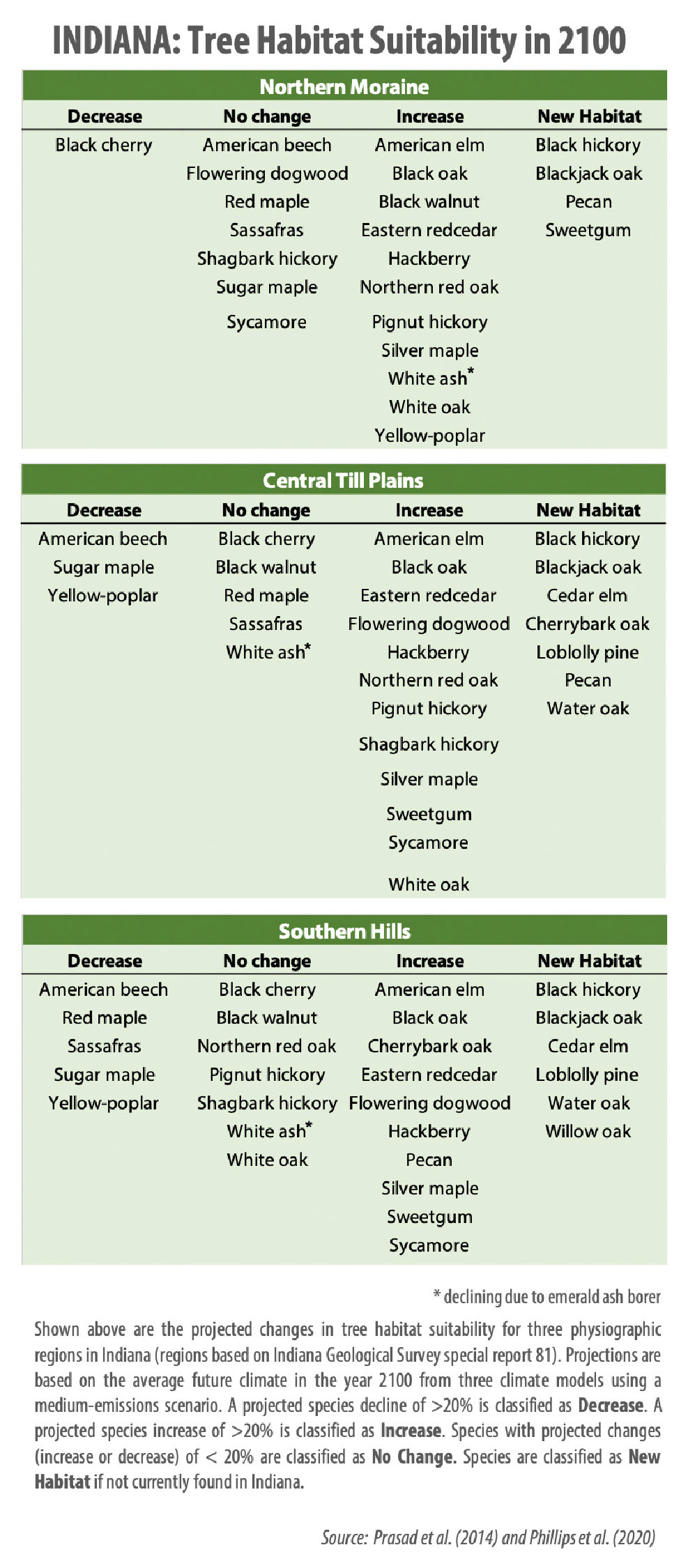Indiana’s Future Forests
Over the next century, rising temperatures and changing precipitation patterns across the Midwest will likely have widespread consequences for Indiana’s forests. Expected changes include shifts in the distributions and abundances of trees, understory plants and wildlife, as well as changes in the environmental, economic and cultural benefits these forests provide.
A recent report from the Indiana Climate Change Impacts Assessment examines the direct and indirect impacts that climate change is expected to have on Indiana’s forests. The report specifically addresses forest regeneration, forest composition, tree growth and harvest, wildlife habitat and forest products. Presented here are a summary of the report’s key findings:
• Predicted changes in climate – warmer, wetter springs followed by hotter, drier summers – may increase habitat suitability for a growing assortment of tree species in Indiana. More species’ habitats are predicted to expand into the state than retract from the state by century’s end. Habitat suitability is expected to increase for 43 to 52 percent of tree species and decrease for 17 to 29 percent of tree species in Indiana.
• A longer growing season and greater concentration of carbon dioxide (CO2) in the atmosphere may increase forest productivity and carbon uptake in the short term. However, increases in the frequency and intensity of spring flooding and summer drought are likely to reduce or erase these benefits. The wetter springs and more frequent flooding will also promote pathogen-related diseases.
• Many of the tree species (e.g., tulip trees and maples), which are positioned to become dominant due to disturbances and forest aging, are poorly adapted to the warm, drier summer conditions that are predicted by most climate models. Thus, changes in forest composition have the potential to decrease forest productivity and carbon uptake. However, management factors, such as rotation length and harvesting intensity, may influence changes in species composition and growth rates.
• Forest regeneration will be affected by changes in the climate, as well as by changes in the abundance of other species such as herbivores and understory plants. Longer growing seasons could help seedlings establish, but increased spring precipitation and flooding, as well as drier summers, may damage seedlings during sensitive phases of growth.
• Changes in climate will likely have varying effects on the proliferation of invasive plants already in the state. Warmer temperatures may increase the number of new invasive species, as plants such as kudzu and Chinese privet expand their ranges northward in response to an altered climate.
• The number of days with frozen soil is projected to drop by one-half to two-thirds by late century, dramatically shrinking the time window for harvesting trees without environmental disturbance and damage. The risk of soil rutting and erosion from harvest activities on wet soil is likely to increase in Indiana.
• Changes in wildlife population densities will be more strongly influenced by changes in forest composition than by the direct effects of a changing climate. Reforestation and restoration efforts that use climate-adapted tree species may reverse some of the negative consequences of species shifts by providing appropriate habitat for vulnerable wildlife.
• Other forest benefits are also likely to be affected by a shifting climate. For instance, maple syrup season is expected to be earlier and shorter, and some species commonly used as Christmas trees, like white pine, are likely to suffer from the warmer temperatures.
You can read the full report, titled Indiana’s Future Forests: A Report from the Indiana Climate Change Impacts Assessment, online at www.IndianaClimate.org.
Melissa Widhalm is an Operations Manager for the Purdue Climate Change Research Center and the coordinator for the Indiana Climate Change Impacts Assessment.
